ristretto 是 golang 社区里排头部的高性能的数据缓存库,支持键值过期和 LFU 缓存淘汰,还支持最大的内存空间限制,根据写时传入 cost 计算已使用的内存值,通常 cost 为对象的 size,但也可以当个数使用。其他缓存库多按照条数进行限制,不合理使用时容易造成 OOM 的风险。
其相比 freecache、bigcache 来说,存储 value 可以为任意值 interface{}。而 freecache、bigcache 内部通过一个大的 ringbuffer 来存放 value,而 value 需要是 []byte 字节数组,该设计对于 golang gc 很友好,但应用上受限,读写的时候需要对进行编码解码,这个开销不低的。
ristretto 在混合读写压测场景下,其吞吐表现要比其他 go cahce 库要好,当然压测的 case 通常是偏向自己的,懂的自然懂。
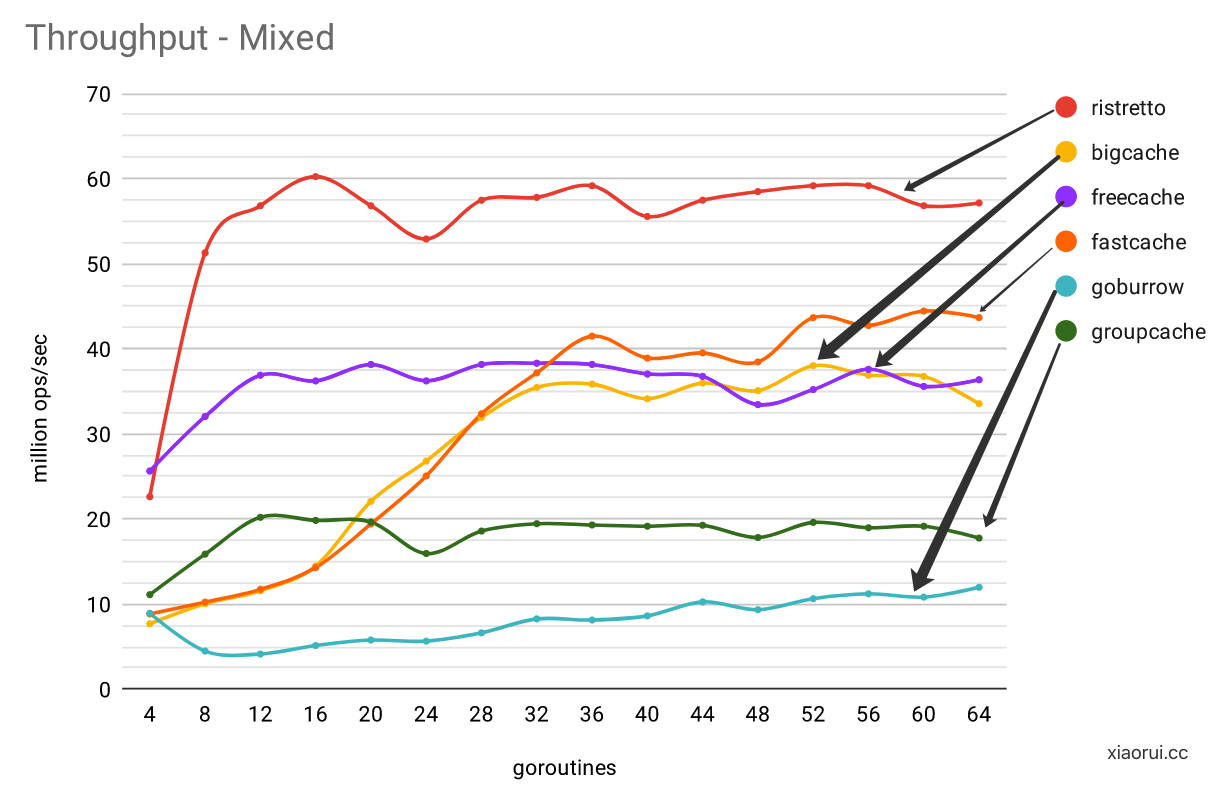
ristretto 使用方法
func main() {
cache, err := ristretto.NewCache(&ristretto.Config{
NumCounters: 1e7, // number of keys to track frequency of (10M).
MaxCost: 1 << 30, // maximum cost of cache (1GB).
BufferItems: 64, // number of keys per Get buffer.
})
if err != nil {
panic(err)
}
// 写数据,cost 为 1.
cache.Set("key", "value", 1)
// 由于 ristretto 是异步写,所以需要等待协程消费处理完.
cache.Wait()
// 获取数据
value, found := cache.Get("key")
if !found {
panic("missing value")
}
fmt.Println(value)
// 删除数据
cache.Del("key")
}
ristretto 项目地址:
https://github.com/dgraph-io/ristretto
ristretto 设计原理
ristretto 的 kv 存储使用分片map来实现的,而缓存淘汰则使用 tinyLFU 实现。
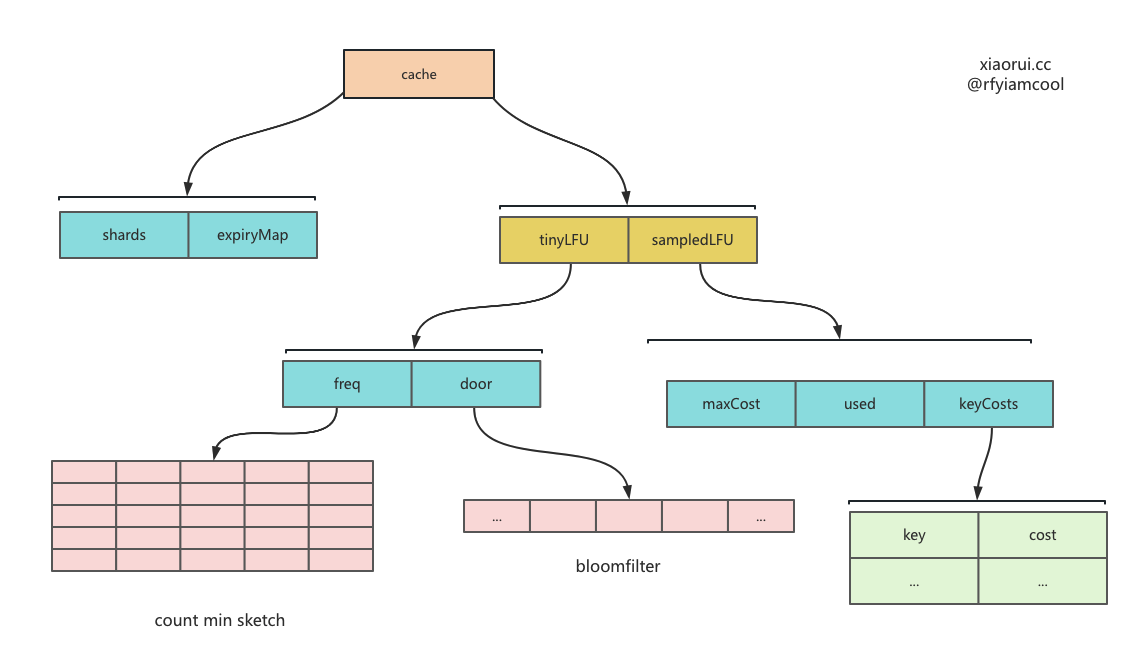
ristretto store 的结构
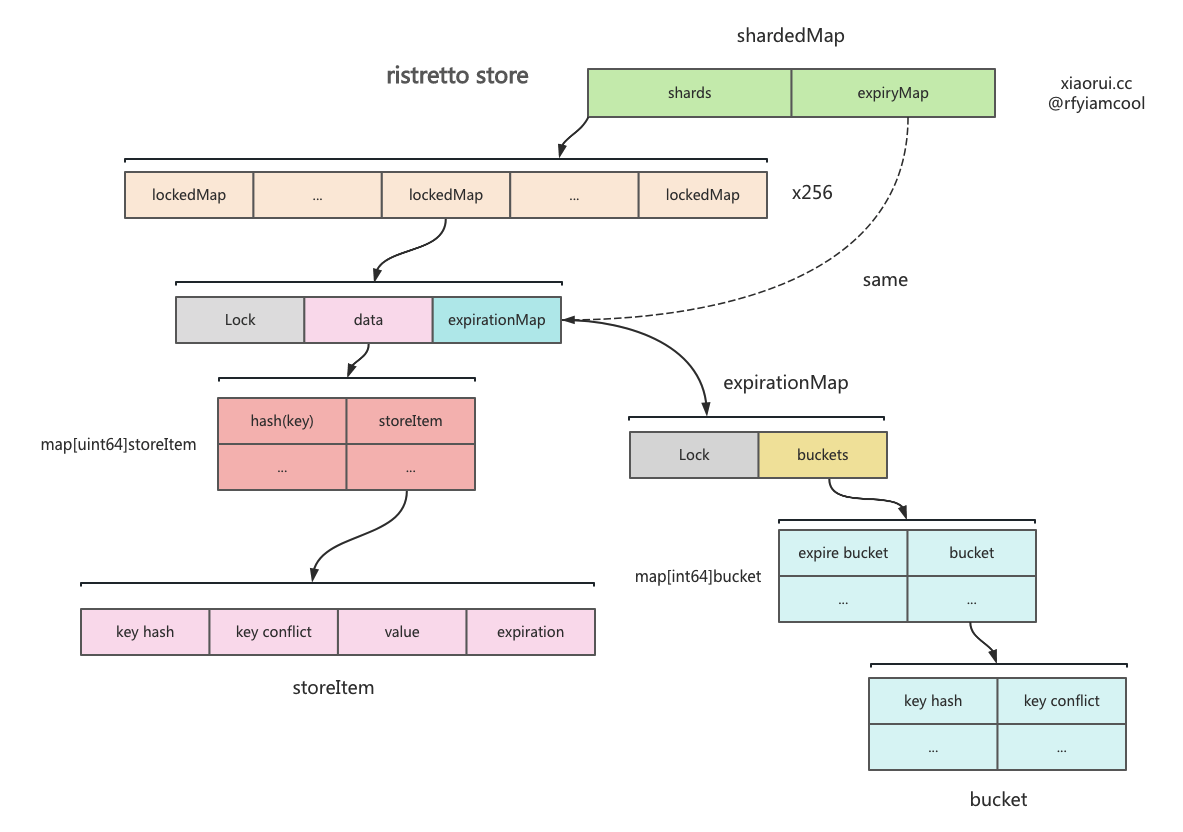
ristretto 设计了一个长度为 256 的分片集合,该结构类型为 shardedMap,其每个分片里有一个存数据的 map 和独立的锁,其目的是为了减少锁竞争,提高读写性能。增删改查的时候,通过对 key 进行取摸定位数据在哪一个 shard 分片上。
shardedMap 内部使用 expirationMap 来存键值过期数据的,所有分片共用一个 expirationMap 对象,ristretto 没有使用分片来构建过期数据集。
// 最大的分片数量,常量不能改.
const numShards uint64 = 256
type shardedMap struct {
shards []*lockedMap
expiryMap *expirationMap
}
func newShardedMap() *shardedMap {
sm := &shardedMap{
shards: make([]*lockedMap, int(numShards)),
expiryMap: newExpirationMap(),
}
for i := range sm.shards {
sm.shards[i] = newLockedMap(sm.expiryMap)
}
return sm
}
type lockedMap struct {
sync.RWMutex
data map[uint64]storeItem // 该 map 的 key 为数据key的哈希值.
em *expirationMap
}
type expirationMap struct {
sync.RWMutex
buckets map[int64]bucket // 该 map 的 key 过期时间的索引值,计算方法为 `ts/5 + 1`
}
// key 为键值 key 的 hash 值,value 为 conflict 值,是另一个 hash 值.
type bucket map[uint64]uint64
shardedMap 里不存储真正的 key 值,而是存储数据 key 两个 hash 值,为什么使用两个 hash 值标记对象,为了避免概率上的冲突,所以另使用另一个 xxhash 算法计算 hash 值,该值在 ristretto 定义为 conflict 哈希值。
KeyToHash 是 ristretto 默认的 hash 方法,传入的 key 不能是指针类型,也不能是 struct。返回值为两个 hash 值,其内部的 MemHash 其实是 runtime.memhash 映射的方法,golang 内部的 map 也使用该 hash 算法。xxhash 则为社区中较为火热的 hash 库。
func KeyToHash(key interface{}) (uint64, uint64) {
if key == nil {
return 0, 0
}
switch k := key.(type) {
case uint64:
return k, 0
case string:
return MemHashString(k), xxhash.Sum64String(k)
case []byte:
return MemHash(k), xxhash.Sum64(k)
case byte:
return uint64(k), 0
case int:
return uint64(k), 0
case int32:
return uint64(k), 0
case uint32:
return uint64(k), 0
case int64:
return uint64(k), 0
default:
panic("Key type not supported")
}
}
ristretto 缓存驱逐策略
社区中常常使用 LRU 和 LFU 算法来实现缓存淘汰驱逐,ristretto 则使用 LFU 算法,但由于 LFU 标准实现开销过大,则使用 TinyLFU 实现数据淘汰。
TinyLFU 里主要使用 count-min sketch 统计算法粗略记录各个 key 的缓存命中计数。该 count-min Sketch 算法通常用在不要求精确计数,又想节省内存的场景,虽然拿到的计数缺失一定的精准度,但确实节省了内存。
但就 ristretto 缓存场景来说,记录 100w 个 key 的计数也才占用 11MB 左右,公式是 ( 100 * 10000 ) * (8 + 4) / 1024/ 1024 = 11MB,这里的 8 为 key hash 的大小,而 4 为 hit 的类型 uint32 大小。
count-min sketch 统计算法实现

count-min sketch 中的 increment 和 estimate 方法实现原理很简单,流程如下。
- 选定 d 个 hash 函数,开一个 dm 的二维整数数组作为哈希表 ;
- 对于每个元素,分别使用d个hash函数计算相应的哈希值,并对m取余,然后在对应的位置上增1,二维数组中的每个整数称为sketch ;
- 要查询某个元素的频率时,只需要取出d个sketch, 返回最小的那一个。
ristretto 对 count-min sketch 并不是一直累计累加的,在 policy 累计对象超过 resetAt 时,则会对 cm-sketch 统计对象进行重置。不然一直递增,缓存淘汰场景下,对于新对象很不友好。
policy 数据结构的设计
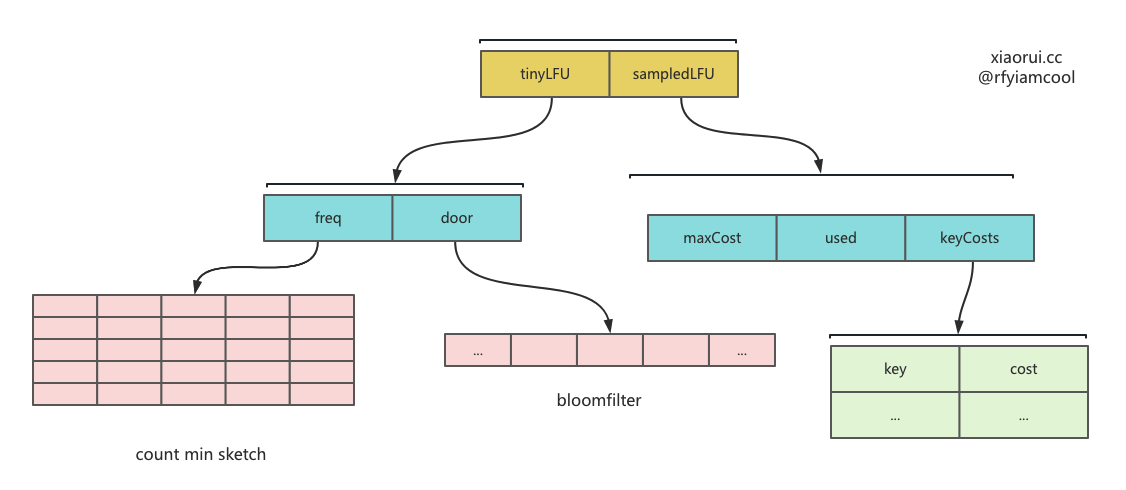
type defaultPolicy struct {
sync.Mutex
admit *tinyLFU // 实现了 tinyLFU 淘汰算法.
evict *sampledLFU // 记录最大 cost,已使用 cost,及 key 对应的 cost 值.
// 异步的维护缓存淘汰策略.
itemsCh chan []uint64
stop chan struct{}
isClosed bool
metrics *Metrics
}
type sampledLFU struct {
maxCost int64 // 最大 cost 阈值
used int64 // 已使用 cost 值
metrics *Metrics // 指标
keyCosts map[uint64]int64 // key 为数据的 key hash,value 为对应的 cost 值.
}
type tinyLFU struct {
freq *cmSketch // count min sketch
door *z.Bloom // bloomfilter
incrs int64
resetAt int64
}
policy tinylfu
policy 在实例化是除了实例化 defaultPolicy 对象,还会启动一个协程运行 processItems 方法,该方法用来监听 cache 传递的增删改事件,在 tinylfu count-min-sketch 里做记录,超过一定阈值后会重置,其目的为了避免老的 lfu freq 越来越大,不容易被淘汰掉。
func newDefaultPolicy(numCounters, maxCost int64) *defaultPolicy {
p := &defaultPolicy{
admit: newTinyLFU(numCounters),
evict: newSampledLFU(maxCost),
itemsCh: make(chan []uint64, 3),
stop: make(chan struct{}),
}
go p.processItems()
return p
}
func (p *defaultPolicy) processItems() {
for {
select {
case items := <-p.itemsCh:
p.Lock()
p.admit.Push(items)
p.Unlock()
case <-p.stop:
return
}
}
}
func (p *tinyLFU) Push(keys []uint64) {
for _, key := range keys {
p.Increment(key)
}
}
func (p *tinyLFU) Increment(key uint64) {
// Flip doorkeeper bit if not already done.
if added := p.door.AddIfNotHas(key); !added {
// Increment count-min counter if doorkeeper bit is already set.
p.freq.Increment(key)
}
p.incrs++
if p.incrs >= p.resetAt {
p.reset()
}
}
写时缓存淘汰驱逐
ristretto 没有实现后台协程主动淘汰驱逐的逻辑,而是采用了写时淘汰驱逐,每次写数据时,判断是否有足够的 cost 插入数据。如果不足,则进行驱逐。采样驱逐的方法有点类似 redis 的方案,每次从 simpleLFU 里获取 5 个 key,然后遍历计算这 5 个 key 的命中率,淘汰掉命中率最低的 key,然后再判断是否有空闲 cost 写入,不足继续采样淘汰,知道满足当前 key 的写入。
命中率是通过 tinyLFU 来计算的,由于该实现是通过 count-min sketch 算法实现,所以计算出的缓存命中数会产生些偏差。
func (p *defaultPolicy) Add(key uint64, cost int64) ([]*Item, bool) {
p.Lock()
defer p.Unlock()
// 添加的 cost 不能超过总 cost 阈值.
if cost > p.evict.getMaxCost() {
return nil, false
}
// 如果 simpleLfu 里有 key 值,则更新 cost 值.
if has := p.evict.updateIfHas(key, cost); has {
return nil, false
}
// 如果 key 在 simpleLFU 不存在,则走下面的逻辑.
// 计算减去 cost 后还剩多少可用的 cost.
room := p.evict.roomLeft(cost)
if room >= 0 {
// 如果足够 cost 开销,则更新 lfu 内指标.
p.evict.add(key, cost)
// 这里的 nil 代表,没有需要淘汰的数据,true 代表可以插入.
return nil, true
}
incHits := p.admit.Estimate(key)
// 构建一个可以放 5 条采样数据的集合
sample := make([]*policyPair, 0, lfuSample)
// 需要删除的 key
victims := make([]*Item, 0)
// 尝试淘汰数据,直到有空余的 cost.
for ; room < 0; room = p.evict.roomLeft(cost) {
// 采样获取 5 条 key,并填满 sample 数组.
sample = p.evict.fillSample(sample)
// 在取样集合里获取中最少被使用的 key,也就是缓存命中率最低的 key.
minKey, minHits, minId, minCost := uint64(0), int64(math.MaxInt64), 0, int64(0)
for i, pair := range sample {
// 获取该 key 的 hits 命中率
if hits := p.admit.Estimate(pair.key); hits < minHits {
minKey, minHits, minId, minCost = pair.key, hits, i, pair.cost
}
}
if incHits < minHits {
p.metrics.add(rejectSets, key, 1)
return victims, false
}
// 在 simpleLFU 中删除 key,且减去 cost.
p.evict.del(minKey)
sample[minId] = sample[len(sample)-1]
sample = sample[:len(sample)-1]
// 把需要淘汰掉的 key 添加到 victims 集合里.
victims = append(victims, &Item{
Key: minKey,
Conflict: 0,
Cost: minCost,
})
}
// 在 simpleLFU 记录 key 的 cost,且累加 cost.
p.evict.add(key, cost)
// 指标
p.metrics.add(costAdd, key, uint64(cost))
return victims, true
}
ristretto 读写流程源码分析
Set 写流程
// 带 cost 参数来写入 kv.
func (c *Cache) Set(key, value interface{}, cost int64) bool {
return c.SetWithTTL(key, value, cost, 0*time.Second)
}
// 带 cost 和过期参数来写入 kv.
func (c *Cache) SetWithTTL(key, value interface{}, cost int64, ttl time.Duration) bool {
// 判空
if c == nil || c.isClosed || key == nil {
return false
}
// 判断过期时间
var expiration time.Time
switch {
case ttl == 0:
break // 其他不加也行
case ttl < 0:
return false
default:
// 当前时间加上 ttl 过期时长为过期时间
expiration = time.Now().Add(ttl)
}
// 使用不同的 hash 算法计算出 key 的两个 hash 值,一个用来做 key 的哈希值,另一个用来用来做判断冲突的哈希值.
keyHash, conflictHash := c.keyToHash(key)
// 构建 item 对象.
i := &Item{
flag: itemNew, // 默认为新增
Key: keyHash,
Conflict: conflictHash,
Value: value,
Cost: cost,
Expiration: expiration,
}
// 判断是有存在值,存在则更新数据及 expire 信息,另外把 flag 设为更新.
if prev, ok := c.store.Update(i); ok {
c.onExit(prev)
i.flag = itemUpdate // 改为 update 更新
}
// 尝试把 item 发给 policy
select {
case c.setBuf <- i:
return true
default:
if i.flag == itemUpdate {
return true
}
// 统计
c.Metrics.add(dropSets, keyHash, 1)
return false
}
}
store update 方法
func (sm *shardedMap) Update(newItem *Item) (interface{}, bool) {
// 通过 key hash 取摸找到 shard,并执行 shard 的 update 方法.
return sm.shards[newItem.Key%numShards].Update(newItem)
}
func (m *lockedMap) Update(newItem *Item) (interface{}, bool) {
m.Lock()
// 判断是否已经存在 ?
item, ok := m.data[newItem.Key]
if !ok {
m.Unlock()
// 无,直接返回
return nil, false
}
// 有,则判断 hash conflict hash 是否一致,不一致则不为同一个值,直接跳出.
if newItem.Conflict != 0 && (newItem.Conflict != item.conflict) {
m.Unlock()
return nil, false
}
// 在 shard expirationMap 里更新过期信息.
m.em.update(newItem.Key, newItem.Conflict, item.expiration, newItem.Expiration)
// 把数据加到 shard data 里.
m.data[newItem.Key] = storeItem{
key: newItem.Key,
conflict: newItem.Conflict,
value: newItem.Value,
expiration: newItem.Expiration,
}
m.Unlock()
// 返回数据和true, 表明更新成功.
return item.value, true
}
ProcessItems
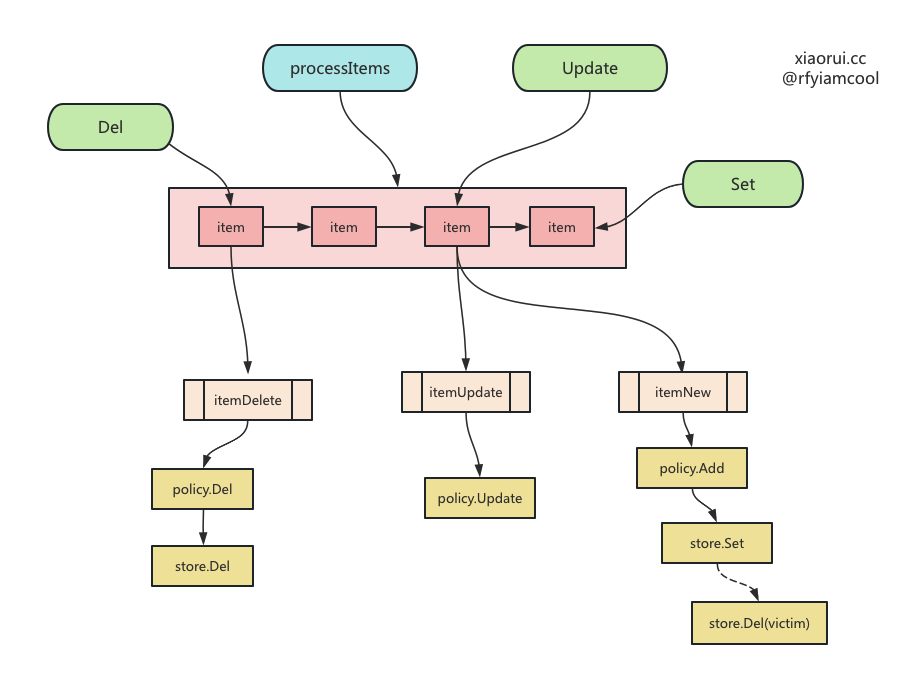
ristretto 实例化的时候会开启一个协程运行 processItems,processItems 方法可以处理 item 的增删改,还可以周期性进行 GC 垃圾回收。
// processItems is ran by goroutines processing the Set buffer.
func (c *Cache) processItems() {
startTs := make(map[uint64]time.Time)
numToKeep := 100000 // TODO: Make this configurable via options.
trackAdmission := func(key uint64) {
if c.Metrics == nil {
return
}
startTs[key] = time.Now()
if len(startTs) > numToKeep {
for k := range startTs {
if len(startTs) <= numToKeep {
break
}
delete(startTs, k)
}
}
}
onEvict := func(i *Item) {
if ts, has := startTs[i.Key]; has {
c.Metrics.trackEviction(int64(time.Since(ts) / time.Second))
delete(startTs, i.Key)
}
if c.onEvict != nil {
c.onEvict(i)
}
}
for {
select {
case i := <-c.setBuf:
if i.wg != nil {
i.wg.Done()
continue
}
// 如果是添加和更新,则需要计算 item 的开销
if i.Cost == 0 && c.cost != nil && i.flag != itemDelete {
i.Cost = c.cost(i.Value)
}
// 判断是否需要忽略内部数据结构的开销.
if !c.ignoreInternalCost {
// 累加 Item 自身的字节开销
i.Cost += itemSize
}
// 根据 flag 类型执行增删改逻辑.
switch i.flag {
case itemNew:
// 当超过阈值时,返回需要删除的数据 victims,added 为是否添加成功.
victims, added := c.policy.Add(i.Key, i.Cost)
if added {
// 在 store 里添加 item 对象.
c.store.Set(i)
// 统计信息
c.Metrics.add(keyAdd, i.Key, 1)
trackAdmission(i.Key)
} else {
// 回调传入的 onreject 方法,且执行 onExit 方法.
c.onReject(i)
}
// 删除相关记录
for _, victim := range victims {
victim.Conflict, victim.Value = c.store.Del(victim.Key, 0)
// 被缓存策略驱逐需要回调 onEvict 方法.
onEvict(victim)
}
case itemUpdate:
// 由于在 cache.Set 方法里处理了 Update 的数据,这里只做 policy 通知即可.
c.policy.Update(i.Key, i.Cost)
case itemDelete:
// 在 policy里 删除
c.policy.Del(i.Key) // Deals with metrics updates.
// 在 store 删除该记录
_, val := c.store.Del(i.Key, i.Conflict)
// 执行回调方法
c.onExit(val)
}
case <-c.cleanupTicker.C:
// 进行 GC 垃圾回收,删除过期的数据.
c.store.Cleanup(c.policy, onEvict)
case <-c.stop:
return
}
}
}
store Set
先从 sharedMap 里找到相关的 shard,然后在 shard 判断是否以前有值, 如果有前值,且 key conflict hash 值不一致,则直接跳出,否则更新 expireMap,然后把 item 接到 shard 的 data 里。
代码位置: github/ristretto/store.go
// 在 shardedMap 里写入.
func (sm *shardedMap) Set(i *Item) {
if i == nil {
return
}
// 对 key hash 取摸计算出 shard,再对 shard 调用 set 来写入.
sm.shards[i.Key%numShards].Set(i)
}
// 在 shard 里写入.
func (m *lockedMap) Set(i *Item) {
if i == nil {
// If the item is nil make this Set a no-op.
return
}
// 执行 shard 内部的锁
m.Lock()
defer m.Unlock()
// 尝试获取先前数据
item, ok := m.data[i.Key]
if ok {
// 如果有前值,且 key conflict hash 值不一致,则直接跳出.
if i.Conflict != 0 && (i.Conflict != item.conflict) {
return
}
// 如果有旧值,则在 expire map 里更新过期时间.
m.em.update(i.Key, i.Conflict, item.expiration, i.Expiration)
} else {
// 如果没有,在 expire map 里添加过期信息.
m.em.add(i.Key, i.Conflict, i.Expiration)
}
// 把 item 里加到 data 里.
m.data[i.Key] = storeItem{
key: i.Key, // key hash1
conflict: i.Conflict, // key hash2
value: i.Value,
expiration: i.Expiration,
}
}
add 在 expirationMap 里添加过期数据,update 则是在 expirationMap 删除以前的过期数据,添加新的过期数据。
代码位置: github/ristretto/ttl.go
var (
bucketDurationSecs = int64(5)
)
// 每 5 秒为一个 bucket.
func storageBucket(t time.Time) int64 {
return (t.Unix() / bucketDurationSecs) + 1
}
func (m *expirationMap) add(key, conflict uint64, expiration time.Time) {
// 判空
if m == nil {
return
}
// 过期为空, 则直接跳出.
if expiration.IsZero() {
return
}
// 通过过期时长获取 bucket 索引.
bucketNum := storageBucket(expiration)
m.Lock()
defer m.Unlock()
// 把 key 和 conflict 加到 bucket 里.
b, ok := m.buckets[bucketNum]
if !ok {
b = make(bucket)
m.buckets[bucketNum] = b
}
b[key] = conflict
}
func (m *expirationMap) update(key, conflict uint64, oldExpTime, newExpTime time.Time) {
if m == nil {
return
}
m.Lock()
defer m.Unlock()
// 删旧
oldBucketNum := storageBucket(oldExpTime)
oldBucket, ok := m.buckets[oldBucketNum]
if ok {
delete(oldBucket, key)
}
// 加新
newBucketNum := storageBucket(newExpTime)
newBucket, ok := m.buckets[newBucketNum]
if !ok {
newBucket = make(bucket)
m.buckets[newBucketNum] = newBucket
}
newBucket[key] = conflict
}
Get 读流程
Get 用来读取数据, 其流程如下。
func (c *Cache) Get(key interface{}) (interface{}, bool) {
// 基本判空
if c == nil || c.isClosed || key == nil {
return nil, false
}
// 使用不同的 hash 算法计算出 key 的两个 hash 值,一个用来做 key 的哈希值,另一个用来用来做判断冲突的哈希值.
keyHash, conflictHash := c.keyToHash(key)
// 调用 ringBuffer 的 push 接口,把 key hash 放进去.
// 其目的用来实现 lfu 策略.
c.getBuf.Push(keyHash)
// 从 store 里获取 value
value, ok := c.store.Get(keyHash, conflictHash)
if ok {
// 如果有值,则在 hit 统计里加一.
c.Metrics.add(hit, keyHash, 1)
} else {
// 如果没有值,则在 miss 统计里加一.
c.Metrics.add(miss, keyHash, 1)
}
// 返回
return value, ok
}
从 shardedMap 里获取数据, 其内部流程是先取摸计算出 key 应该在哪个 shard,然后再从 shard 里获取 kv,然后对比 key conflict hash 值,不一致则说明不是同一条数据,接着判断 kv 是否过期,如过期也返回 false,不过期则返回数据。
// 从 shardedMap 里获取数据.
func (sm *shardedMap) Get(key, conflict uint64) (interface{}, bool) {
return sm.shards[key%numShards].get(key, conflict)
}
// 从 shard 里获取数据.
func (m *lockedMap) get(key, conflict uint64) (interface{}, bool) {
m.RLock()
item, ok := m.data[key]
m.RUnlock()
if !ok {
return nil, false
}
if conflict != 0 && (conflict != item.conflict) {
return nil, false
}
// 判断是否超时,当 kv 过期超时,这里不主动删除数据,而直接返回无数据的错误.
// 这里的删除等待定时器的 gc 垃圾回收处理.
if !item.expiration.IsZero() && time.Now().After(item.expiration) {
return nil, false
}
// 返回数据
return item.value, true
}
Del 删除数据
Del 用来删除数据, 其流程如下。
// Del deletes the key-value item from the cache if it exists.
func (c *Cache) Del(key interface{}) {
// 判空
if c == nil || c.isClosed || key == nil {
return
}
// 通过不同的 hash 算法获取 key 的两个 hash 值.
keyHash, conflictHash := c.keyToHash(key)
// 在 store 里删除数据
_, prev := c.store.Del(keyHash, conflictHash)
// 回调 exit 方法
c.onExit(prev)
// 像 setBuf 里传递 item 对象,flag 标记为 delete.
c.setBuf <- &Item{
flag: itemDelete,
Key: keyHash,
Conflict: conflictHash,
}
}
从 shardedMap 里删除数据,其流程如下。
- 通过 key hash 获取 item ;
- 判断 hash conflict hash 值是否一致,不一致则直接 return ;
- 如果 item 配置了过期时间,则在 expirationMap 里删除相关记录 ;
- 在 map 里删除 item.
// 从 shardedMap 里删除数据.
func (sm *shardedMap) Del(key, conflict uint64) (uint64, interface{}) {
return sm.shards[key%numShards].Del(key, conflict)
}
// 从 shard 里删除数据.
func (m *lockedMap) Del(key, conflict uint64) (uint64, interface{}) {
m.Lock()
// 通过 key hash 获取 item
item, ok := m.data[key]
if !ok {
// 没有值,无需删除,返回
m.Unlock()
return 0, nil
}
// 判断 hash conflict hash 值是否一致.
if conflict != 0 && (conflict != item.conflict) {
m.Unlock()
return 0, nil
}
// 如果 item 配置了过期时间,则在 expirationMap 里删除.
if !item.expiration.IsZero() {
m.em.del(key, item.expiration)
}
// 删除 item.
delete(m.data, key)
m.Unlock()
// 返回 hash 冲突值和 value.
return item.conflict, item.value
}
expire gc 过期垃圾回收的设计原理
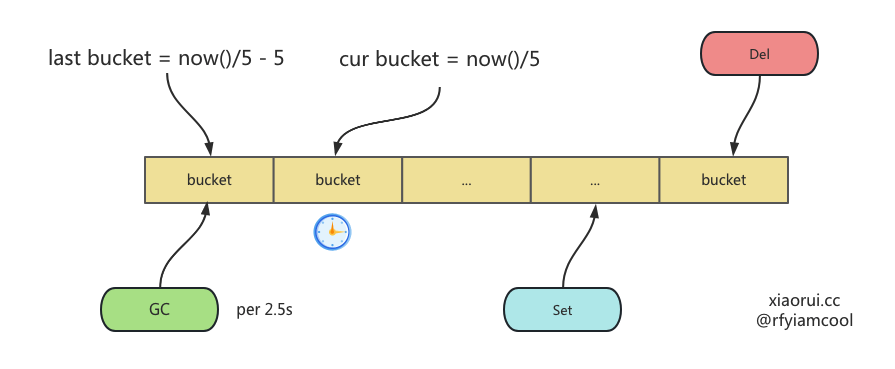
ristretto 初始化会启动一个协程来执行 processItems, 该方法里不仅监听 setBuf 管道来对数据增删改,且还会监听垃圾回收定时器来完成垃圾回收。 每 2.5 秒调用 Cleanup 方法执行过期键的垃圾回收。
var (
bucketDurationSecs = int64(5)
cleanupTicker = time.NewTicker(time.Duration(bucketDurationSecs) * time.Second / 2),
)
func (c *Cache) processItems() {
startTs := make(map[uint64]time.Time)
numToKeep := 100000
onEvict := func(i *Item) {
if ts, has := startTs[i.Key]; has {
c.Metrics.trackEviction(int64(time.Since(ts) / time.Second))
delete(startTs, i.Key)
}
if c.onEvict != nil {
c.onEvict(i)
}
}
for {
select {
case i := <-c.setBuf:
// ...
case <-c.cleanupTicker.C:
// 执行过期数据垃圾回收.
c.store.Cleanup(c.policy, onEvict)
}
}
}
Cleanup 是过期键垃圾回收的核心方法,其内部流程如下。
先获取当前时间点以前的 bucket,然后遍历该 bucket 内的所有 keys,判断是否过期,如过期则在 store 里删除 item,没过期则跳过。
func (sm *shardedMap) Cleanup(policy policy, onEvict itemCallback) {
sm.expiryMap.cleanup(sm, policy, onEvict)
}
func cleanupBucket(t time.Time) int64 {
return storageBucket(t) - 1
}
func (m *expirationMap) cleanup(store store, policy policy, onEvict itemCallback) {
// 判空
if m == nil {
return
}
m.Lock()
now := time.Now()
// 取出当前时间对应的上一个 bucket 时间点.
bucketNum := cleanupBucket(now)
// 取出该 bucket 的 key hash 和 conflict hash.
keys := m.buckets[bucketNum]
// 在 buckets 集合里删该 bucket.
delete(m.buckets, bucketNum)
// 放锁,因为后面的路基是慢逻辑.
m.Unlock()
// 遍历上一个 bucket 的 key hash 集合, 尝试删除过期的键值.
for key, conflict := range keys {
// 没过期,跳过
if store.Expiration(key).After(now) {
continue
}
// 如过期获取 key 的 cost 开销值.
cost := policy.Cost(key)
// 在 policy 里删除 key.
policy.Del(key)
// store 里删除该值.
_, value := store.Del(key, conflict)
// 执行回调方法.
if onEvict != nil {
onEvict(&Item{Key: key,
Conflict: conflict,
Value: value,
Cost: cost,
})
}
}
}
总结
简单说, ristretto 的 kv 存储使用分片map来实现的,而缓存淘汰则使用 tinyLFU 实现。


